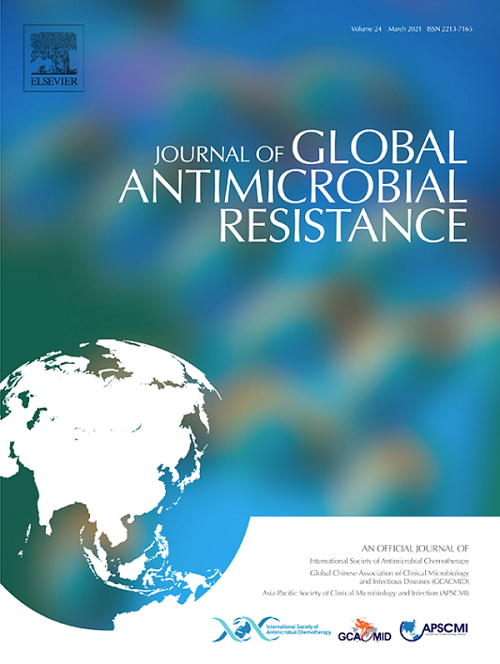Plasmidome analyses of Klebsiella pneumoniae co-producing blaKPC-2 and blaNDM-1 in Southern Brazil: characterisation of mobile genetic elements
IF 3.2
3区 医学
Q2 INFECTIOUS DISEASES
引用次数: 0
Abstract
Objective
Infections due to carbapenemase-producing Enterobacterales harbouring more than one carbapenemase-encoding gene spread mainly by plasmid and transposon mobilisation. The objective of this study was to analyse the mobile genetic elements carrying blaKPC and blaNDM of Klebsiella pneumoniae carbapenemase co-producers (KpKN).
Methods
K. pneumoniae isolates with reduced susceptibility to carbapenems were obtained between 2016 and 2023. To evaluate the genetic environment of KpKN, 22 isolates were selected for antimicrobial susceptibility testing and whole-genome sequencing.
Results
The blaKPC-2 gene was carried mainly by IncN/IncFIB, a novel co-integrated plasmid in the Tn4401b transposon. blaNDM-1 was disseminated in the only two KpKN isolates recovered prior to 2020 by the IncHI1B/IncFIB plasmid type within the Tn3000 transposon. Significantly, isolates obtained since 2020 showed the blaNDM-1 gene carried by IncA/C in an IS26-flanked pseudo-composite transposon containing ISCR1, which also had genes that conferred resistance to sulfonamides, aminoglycosides, macrolides, quinolones, amphenicols, tetracyclines, rifampicin, sulfonamide, and trimethoprim. The isolates belonged mainly to ST11 and ST16.
Conclusions
Plasmid and transposon changes during different periods could be related to higher dissemination of blaNDM-1, and the large number of resistance genes present in the IS26-flanked transposon may have increased co-selection of this plasmid through the wide use of antimicrobials during the pandemic.
巴西南部共产blaKPC-2和blaNDM-1的肺炎克雷伯菌质粒分析:移动遗传元件的表征
目的:携带多个碳青霉烯酶编码基因的产碳青霉烯酶肠杆菌感染主要通过质粒和转座子动员传播。目的:分析肺炎克雷伯菌碳青霉烯酶共生菌(KpKN)携带blaKPC和blaNDM的移动遗传元件。方法:2016 - 2023年对碳青霉烯类药物敏感性降低的肺炎克雷伯菌分离株。为评价KpKN的遗传环境,选取22株菌株进行药敏试验和全基因组测序(WGS)。结果:blaKPC-2基因主要由Tn4401b转座子中的新型共整合质粒IncN/IncFIB携带。blaNDM-1在2020年之前通过IncHI1B/IncFIB质粒类型在Tn3000转座子中恢复的仅有两个KpKN分离株中播散。值得注意的是,自2020年以来获得的分离株显示,IncA/C在含有ISCR1的is26侧翼伪复合转座子中携带blaNDM-1基因,该基因还具有对磺胺类药物、氨基糖苷类药物、大环内酯类药物、喹诺酮类药物、霉素类药物、四环素类药物、利福平、磺胺类药物和甲氧苄啶具有耐药性的基因。分离株主要属于ST11和ST16。结论:质粒和转座子在不同时期的变化可能与blaNDM-1的高传播有关,is26侧转座子中存在大量耐药基因可能通过在大流行期间广泛使用抗菌剂增加了该质粒的共选择。
本文章由计算机程序翻译,如有差异,请以英文原文为准。
求助全文
约1分钟内获得全文
求助全文
来源期刊

Journal of global antimicrobial resistance
INFECTIOUS DISEASES-PHARMACOLOGY & PHARMACY
CiteScore
8.70
自引率
2.20%
发文量
285
审稿时长
34 weeks
期刊介绍:
The Journal of Global Antimicrobial Resistance (JGAR) is a quarterly online journal run by an international Editorial Board that focuses on the global spread of antibiotic-resistant microbes.
JGAR is a dedicated journal for all professionals working in research, health care, the environment and animal infection control, aiming to track the resistance threat worldwide and provides a single voice devoted to antimicrobial resistance (AMR).
Featuring peer-reviewed and up to date research articles, reviews, short notes and hot topics JGAR covers the key topics related to antibacterial, antiviral, antifungal and antiparasitic resistance.
 求助内容:
求助内容: 应助结果提醒方式:
应助结果提醒方式:


